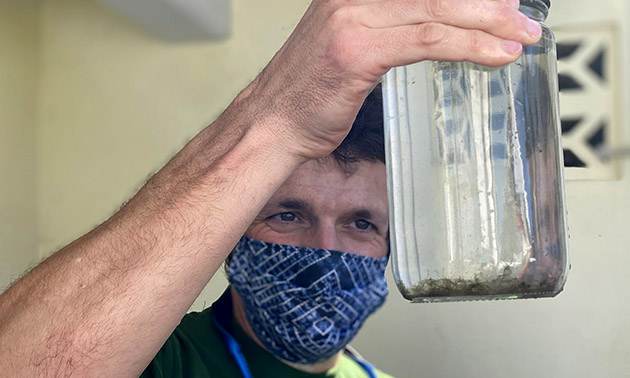Posted in:
An Unexpected Source for Copepods

BIOS zooplankton ecologist Leocadio Blanco-Bercial examines copepods and other marine life collected from an intake pipe at the Bermuda Aquarium, Museum, and Zoo (BAMZ). The project started by looking at copepods that came into the BIOS saltwater plumbing systems via the island’s subterranean caves.
Like all marine scientists, ecologist Leocadio Blanco-Bercial rejoices in the discovery of rare sea creatures. He just never expected to find them showing up in his toilet water.
Bermuda overlays a complex system of caves and fissures that house some of the world’s rarest, oldest, and strangest copepods, small or microscopic aquatic crustaceans that make their homes in the dark interstices of rock and saltwater. Reaching these animals often involves awkward, and sometimes dangerous, climbs into the caves in diving gear or with underwater robots through narrow, contorted entrances, followed by immersion in subterranean pools.
Blanco-Bercial had heard about copepods in the island’s saltwater plumbing system from various colleagues since his arrival at BIOS in 2015. This winter, curious to find out more and advance his cave copepod studies, he got creative. After stringing a plankton net for three hours under the saltwater feed line for the toilet system in his lab on the BIOS campus, Blanco-Bercial was rewarded with what he called one of those “unusually rare creatures.” He plans to use this sand-grain size copepod as part of a collaborative effort to complete a comprehensive copepod family tree aimed at understanding the evolution of this group over the last 500 million years.

In many ways, sampling for copepods at BAMZ is easier than collecting them from their homes in the dark interstices of rock and saltwater. Reaching these animals often involves awkward, and sometimes dangerous, climbs into the caves in diving gear or with underwater robots through narrow, contorted entrances, followed by immersion in subterranean pools.
By Blanco-Bercial’s estimates, many copepods inhabiting water that pools in the island’s hundreds of caves have yet to be fully understood, or even identified.
“We have very little information about who lives in that water, and what they are doing there, and that is exciting to me,” he said. A population geneticist, Blanco-Bercial seeks to answer larger questions about how copepods—critical to the marine food web—are dispersed throughout the globe and how they have evolved.
Since his “toilet” study, he has discovered a more graceful way of sampling in collaboration with the Bermuda Aquarium, Museum, and Zoo (BAMZ). It turns out that water from the aquarium is also drawn from a seawater well. BAMZ officials gave him permission to sample the organisms caught in the inline filters. Just like the water coming into BIOS, Blanco-Bercial found that this water, which comes from a large cave system, is full of unique and rare cave shrimp and copepods.

Blanco-Bercial identified this copepod species as Erebonectes nesioticus. By Blanco-Bercial’s estimates, many copepods inhabiting water that pools in the island’s hundreds of caves have yet to be fully understood, or even identified. “We have very little information about who lives in that water, and what they are doing there, and that is exciting to me,” he said.
Because different copepods live in different cave habitats, he said he won’t give up on accessing the caves using certified cave SCUBA divers, a remote-controlled robot, or other traditional means. But using water from BAMZ has made sampling easier and much more frequent. So far he has captured many rare copepods and two “ultra-rare” (and potentially new) species.
“It is amazing, all these copepods, swimming happily in the seawater wells,” he said. “Some people have to work for hours and days to get to this water. We have it delivered.”
Tagged: